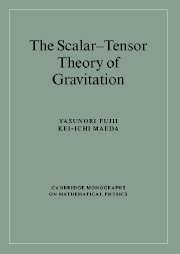Book contents
- Frontmatter
- Contents
- Preface
- Conventions and notation
- 1 Introduction
- 2 The Prototype Brans–Dicke model
- 3 Conformal transformation
- 4 Cosmology with Λ
- 5 Models of an accelerating universe
- 6 Quantum effects
- Appendix A The scalar field from Kaluza-Klein theory
- Appendix B The curvature scalar from the assumed two-sheeted space-time
- Appendix C The field equation of gravity in the presence of nonminimal coupling
- Appendix D The law of conservation of matter
- Appendix E Eddington's parameters
- Appendix F Conformal transformation of a spinor field
- Appendix G Conformal transformation of the curvature scalar
- Appendix H A special choice for conformal invariance
- Appendix J The matter energy–momentum nonconservation law in the E frame
- Appendix K A modification to the Λ term
- Appendix L Einstein's equation in the brane world
- Appendix M Dilatation current
- Appendix N Loop integrals in continuous dimensions
- Appendix O A conformal frame in which particle masses are finally constant
- References
- Index
2 - The Prototype Brans–Dicke model
Published online by Cambridge University Press: 24 August 2009
- Frontmatter
- Contents
- Preface
- Conventions and notation
- 1 Introduction
- 2 The Prototype Brans–Dicke model
- 3 Conformal transformation
- 4 Cosmology with Λ
- 5 Models of an accelerating universe
- 6 Quantum effects
- Appendix A The scalar field from Kaluza-Klein theory
- Appendix B The curvature scalar from the assumed two-sheeted space-time
- Appendix C The field equation of gravity in the presence of nonminimal coupling
- Appendix D The law of conservation of matter
- Appendix E Eddington's parameters
- Appendix F Conformal transformation of a spinor field
- Appendix G Conformal transformation of the curvature scalar
- Appendix H A special choice for conformal invariance
- Appendix J The matter energy–momentum nonconservation law in the E frame
- Appendix K A modification to the Λ term
- Appendix L Einstein's equation in the brane world
- Appendix M Dilatation current
- Appendix N Loop integrals in continuous dimensions
- Appendix O A conformal frame in which particle masses are finally constant
- References
- Index
Summary
As was emphasized in the preceding chapter, the way the scalar field enters the arena of the scalar–tensor theory is not simple. It does so through what is known as a nonminimal coupling term. This is a unique feature shared by those models qualified to be called scalar–tensor theories in the sense conceived by Jordan. In spite of the simplicity of wanting to implement a variable gravitational “constant,” this term is a somewhat contrived technical device that tends to obscure other issues of physical significance. One of the emphases in this chapter is placed on revealing them beyond mathematical manipulations.
Among several versions, or models, of the scalar–tensor theory, the one due to Brans and Dicke might be viewed as a “prototype.” This model, which is based on certain assumptions made for the sake of simplicity, is in fact over-simplified from the point of view of theoretical models of the modern unification program. Also for some other reasons, this model may not be accepted as fully realistic. Nevertheless, a prototype has its own merit that deserves careful and comprehensive understanding. In this chapter we introduce the original BD model as a basis of the subsequent developments.
Section 1 is an elementary but technical introduction to the prototype BD model as a basis of the whole discussion that follows.
- Type
- Chapter
- Information
- The Scalar-Tensor Theory of Gravitation , pp. 37 - 60Publisher: Cambridge University PressPrint publication year: 2003



